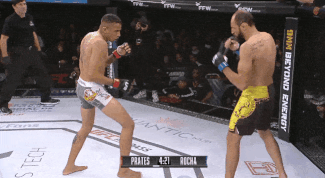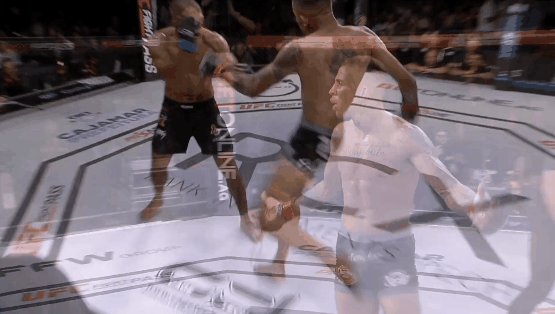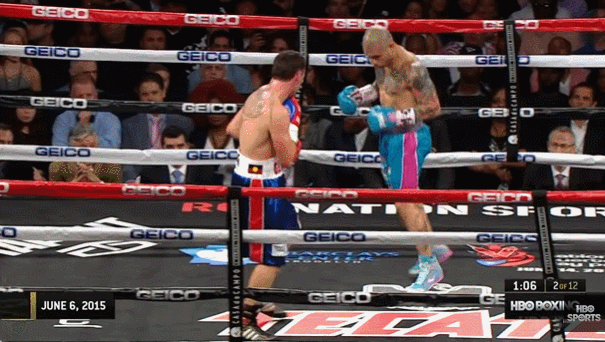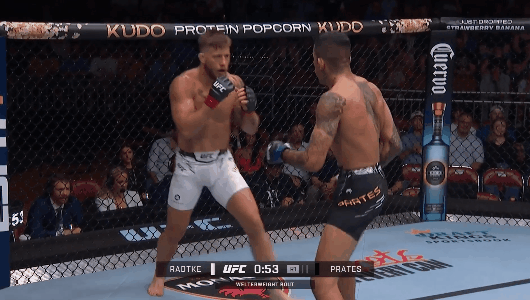Carlos Prates - The Nightmare
On the fight fan’s list of Reasons to be Cheerful in 2024, The Fighting Nerds rank highly. Caio Borralho was the first of the team to make it to the UFC back in 2022, and he graduated into a legitimate middleweight contender earlier this year with an impressive victory over Jared Cannonier. It has proven to be the Year of the Nerd as Jean Silva, Carlos Prates and Mauricio Ruffy all arrived in the UFC and in just ten months went 7-0 with seven stoppages. Now Prates has been given the main event slot on one of the UFC’s regular “Apex slop” cards, against the old veteran Neil Magny, and this seems a great time to examine his game.
It is Prates’ lanky frame that makes him “The Nightmare” at welterweight. Standing six one, he is already taller than most welterweights, but his disproportionate 78 inch reach only adds to the puzzle. Letting Prates put you on the end of his effective range is a horrible prospect. His victory over Charles Radtke came the moment that Radtke stopped pushing towards Prates, and let Prates pressure him back to the fence. Stuck on the end of Prates’ reach, Radtke found his lead hand being not just checked but held at the wrist, as Prates pitched in a long left straight from far beyond Radtke’s range. A left knee followed to score the knockout.
That frightening range advantage can be seen just as clearly in Prates’ fight against Li Jingliang. As soon as Prates could consistently back Li up, Li found himself along the fence and tried to strike his way off. Prates—so much taller and longer than Li—dropped away from Li’s swings and came back with stiff counter punches to put The Leech on his rump.
But Prates would still not be so difficult to deal with were he not also a fantastic hitter. His fight against Trevin Giles was not a very convincing showing on the feet, and Giles had somewhat worked him out, but it only took a couple of good connections from Prates to turn the whole fight upside down. So the Prates problem can be summed up by saying that he is hard to hit with more than one glancing blow at a time, and hits powerfully enough that he only needs to land a once or twice for the fight to start spiraling out of control. Then you must add that he can attempt all his strikes from a half foot further away.
In studying Prates, there are some similarities with UFC middleweight, Roman Kopylov. Both southpaws make a habit of circling to the inside of the opponent’s lead foot. Defensively, they spiral out—back and to the left. Offensively, they keep tight to the line of the opponent’s lead foot and do not step down the outside of it in the “southpaw 101” style that has been taught in boxing since the mid twentieth century. Both Kopylov and Prates work well with their left round kick by taking the preliminary step tight, just down the inside of the opponent’s lead foot.
When you step outside the opponent’s lead foot and throw the body kick it feels good because you are putting the target at about the 80% mark of your kick’s path, when it will really be flying. Stepping inside the opponent’s lead foot means you must almost over-rotate, but it is far trickier for the opponent to read.
The left round kick is a building block for Prates, as he benefits from the classic southpaw double attack of body kick and high kick. More than that, his left round kick can be paired with his left straight and his left knee, both of which involve the same squaring of the shoulders and hips and can disguise each other.
Prates loves to kick off the rear leg and then immediately lunge in with the one-two. This involves returning his kicking foot to the floor just behind his lead foot so that he can lunge in and cover more ground. He will often perform this off the knee to the body, but his fight with Eduardo Ramon shows a classic example of high kicking into the guard to off-balance (and possible stun) Ramon, before leaping in to capitalize with the one-two.
But none of that is unusual. The tricky southpaw sniper is not uncommon in MMA after all, we have already likened him to Roman Kopylov. Yet there are two aspects of Prates’ striking game that make him stand out:
His use of his shoulders and elbows on defence
His left knee
When Prates spirals out, he ducks down behind his lead shoulder and often extends his right arm in a long guard or projects a high right elbow in Dustin Poirier’s “crawfish shell.” As he drops back to his left his opponent’s right hand falls short and they usually follow up with a big left swing that has almost no chance of connecting around Prates’ guard and with Prates’ head dipped off behind his lead shoulder.
You will also see Prates occasionally square up with the lead hand low and elbow projected in the strange way that Dustin Poirier does when he hits the fence. The jury is out on whether this is a good, bad or—most likely—neutral thing to do.
Prates uses his lead shoulder to roll off shots as he pivots around his lead foot to get out the other side of his opponent. Eighty percent of the time he will “defend” strikes by simply retreating and spiraling off to his left. When he is caught in an exchange, he will perform a tight pivot out to his right which is more visually impressive. My usual example of this pivot is Miguel Cotto, who used it to break off his opponents from combination punching when he went up to middleweight.
Then there is his knee. His stepping left knee you will have seen: he used it to knock out Charles Radtke and chinned Eduardo Ramon with it earlier in this article.
But he has a more sinister knee, the one that seems to sneak up on his opponents and slow them down. This is the knee that Prates throws up on the spot, while leaning back. He fires it up to the jaw or under the opponent’s right armpit as they swing.
If ever a technique could be called “height bullying” it is this one. In his fights with Radtke and Giles, Prates used this to intercept them as they stepped in to strike, and ate their punches but was saved from the brunt of them because he leaned back so far that they simply ran out of steam.
It is a relatively small arsenal of techniques, combined with Prates unique physical attributes, that make him such a problem at welterweight. But praise should also be given to Prates for displaying some sturdy takedown defense in his fights with Giles and Radtke. Neil Magny may test that to some extent, if he can close the gap with his footwork and double jabs.
More interesting are the exploitable habits in Prates’ standing game. The extent to which he relies on dropping back to his left whenever the opponent shows him an attack means that with a little ringcraft, he can be reliably directed onto the fence. The guys who have exploited this have been trying to double leg him along the boundary, but in truth the cage does more to hamper his striking. He cannot drop away and have his upper body disappear over the horizon if you step in to punch him up against the cage.
Equally compelling was Trevin Giles’ success playing the low kick game with Prates. Prates is billed as the Muay Thai guy, so much so that he had it written across his chest to remind everyone, but he became considerably more hittable when Giles started poking his lead leg.
When Giles brought out the low line side kick, Prates went Lumpinee mode and began bouncing his lead leg.
Then Giles would feign the sidekick, and run in punching. With one foot off the floor, Prates was slow off the mark in his long retreats.
Prates’ other response to the low line side kick was to try to walk through it. In this instance he stays heavy on his lead foot and tries to walk Giles down, but Giles cracks him with another quick punching combination because Prates is fighting so heavy on the front foot.
The nature of retreat is that you have to feel comfortable driving back off your lead foot and then having it trail as the last thing to leave striking range. Retreat heavy fighters are vulnerable to low kicks already, and when they try to adapt to deal with low kicks they become less mobile as a trade off.
Ultimately Prates knocked Giles out, so it did not hinder him too much or draw too much attention to his difficulties. But for a round and a half he was looking far from the striking savant that was promised and all it took was a little low kicking and flapping of hands.
This weekend Prates faces the Neil Magny test. Magny famously becomes half a fighter the moment an opponent begins low kicking, but does provide a test in the wrestling and on the gas tank if he can make it out of the early going. It will either be another impressive victory for The Fighting Nerds, or at least another hype train derailment to give us something to talk about over the slow coming weeks.











